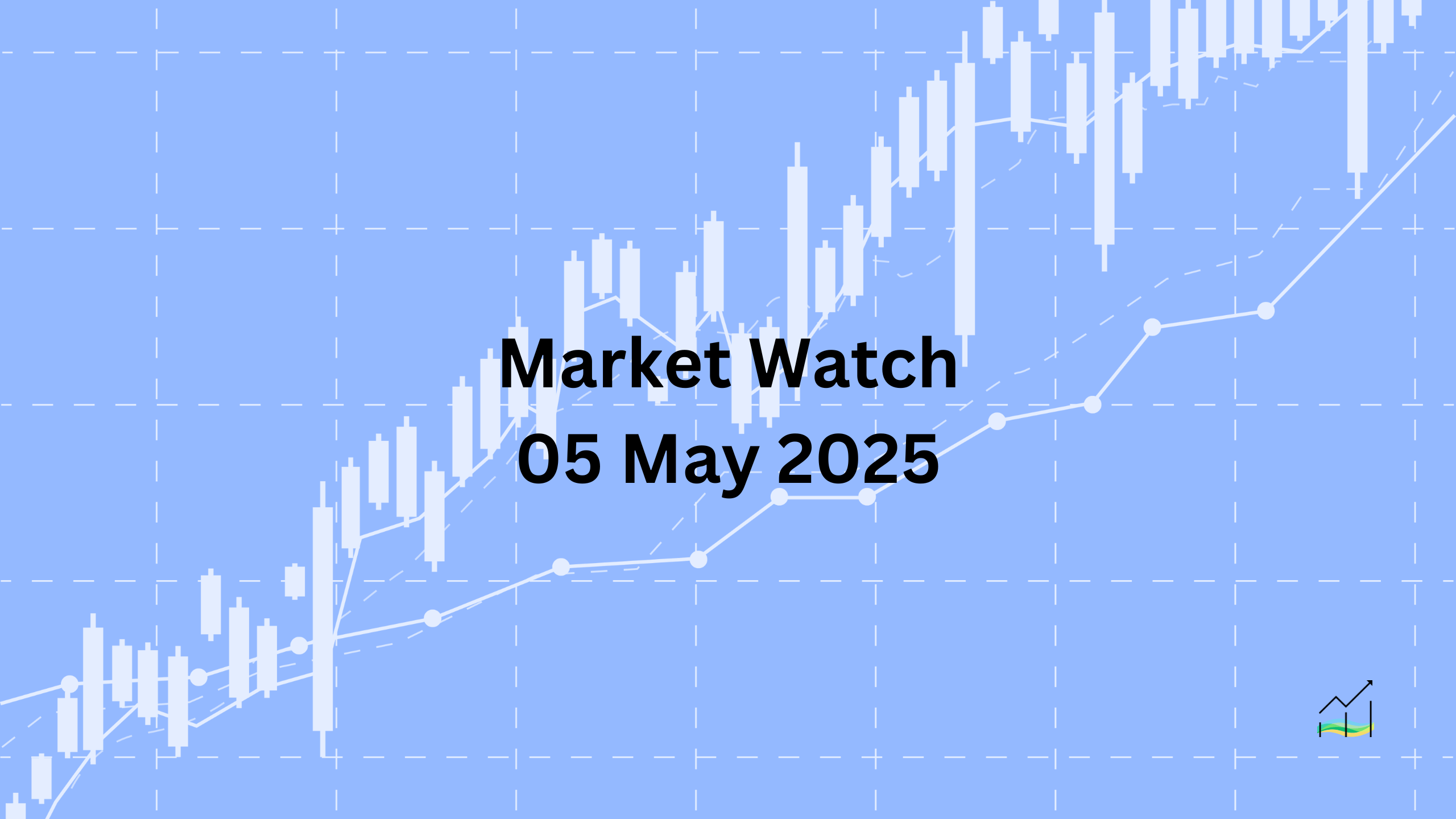05/05/2025 Market Watch

Dollar Drops as Asia FX Gains in Quiet Holiday Trade
Key Takeaways:
- The US dollar is under pressure as Asia Pacific currencies gain strength.
- Markets are reacting to speculation about US semiconductor tariffs and potential currency revaluation agreements.
- Australian dollar hits a five-month high after Labor Party election victory.
- Equity markets show mixed performance amid holiday-thinned trading.
- Gold rebounds strongly after last week’s decline; oil retraces losses following OPEC+ announcement.
The US dollar has started the new week on the back foot, weighed down by a confluence of geopolitical and economic speculation, despite many major financial centers being closed for holidays. Notably, Asia Pacific currencies are showing considerable strength, with the offshore Chinese yuan, Taiwanese dollar, Japanese yen, Malaysian ringgit, and Australian dollar all outperforming. One catalyst is speculation that the US may announce new semiconductor tariffs this Wednesday. In parallel, there is renewed talk of a potential currency agreement reminiscent of the 1985 Plaza Accord — though this remains speculative. More grounded is the possibility that the US will push for targeted currency revaluations in upcoming trade negotiations.
The Australian dollar has surged to a fresh five-month high, following a strong election win by the ruling Labor Party. This political stability appears to be reinforcing positive sentiment towards the currency. Meanwhile, most Asia Pacific equity markets that remained open delivered mixed results — with Taiwan and Australia posting declines, while New Zealand saw modest gains.
In Europe, markets are also trading with limited conviction. European indices are mixed, while US futures point to a soft start, with losses of up to 0.90%. Bond markets reflect a cautious tone: European benchmark yields are slightly lower, and US Treasury futures suggest a sharp drop in yields, though the cash market remains shut due to holidays in both Tokyo and London.
Commodities are regaining ground. After falling 2.4% last week, gold has rebounded nearly 2% today, reclaiming the $3300 level. Oil markets, initially shaken by OPEC+'s announcement of an additional 411,000 barrels per day in production to penalise overproduction, gapped lower but quickly recovered. June WTI is now trading around $57.50 in the European morning after being rejected near $60 late last week.
United States of America
Overview
The US dollar is consolidating within its recent range following a brief attempt at a breakout late last week. After initially showing signs of forming a bottoming pattern, the dollar’s retreat before the weekend created a mixed technical outlook. Despite this, the broader macro landscape still leans in favor of a continued dollar recovery. The labor market remains resilient, the Federal Reserve is widely expected to maintain a hawkish stance at this week’s policy meeting, and momentum indicators still support upside. However, today's softer yields, alongside declines in equities and crude oil, have led to a more cautious tone in dollar movement.
This week’s focus will likely shift toward potential trade developments, particularly surrounding a possible announcement of new US semiconductor tariffs on Wednesday. While today’s release of final April PMIs may draw some attention, the services ISM will be more closely watched. Nonetheless, such survey data are unlikely to sway the Federal Reserve’s decisions, either this week or in June. The nonfarm payrolls report continues to reinforce the view that soft survey results are not yet spilling over meaningfully into real economic activity. Recent distortions in Q1 GDP are largely being discounted.
Economic Drivers
- Market expectations for a hawkish pause by the Federal Reserve this Wednesday.
- Ongoing strength in US labor market data, especially nonfarm payrolls.
- Anticipated announcement of new semiconductor tariffs this week.
- Reduced weight placed on soft survey data due to lack of real-sector impact.
- Pullback in yields and risk assets contributing to near-term dollar consolidation.
Data and Events
- May 5, 2025: Final April S&P Global Services PMI.
- May 5, 2025: Final April S&P Global Composite PMI.
- May 5, 2025: April ISM Services PMI.
- May 8, 2025: Fed Interest Rate Decision and Statement.
Price Action
- Dollar Index remains inside Friday’s range, consolidating near 99.40 support.
- Mixed technical signals following a failed breakout attempt last week.
- Downward pressure from falling yields and equity market softness.
Key Points:
- Dollar outlook remains constructive but near-term momentum is uncertain.
- Fed’s policy stance and US jobs data support the case for continued dollar strength.
- Market attention turning to potential tariff news and services ISM.
- Technical picture is unclear after Friday’s failed breakout.
- Dollar Index holding near critical support around 99.40.
Australia
Overview
Australia’s ruling Liberal Party secured a clear electoral victory, in line with pre-election polling. The result also mirrored a broader political trend seen in other developed economies this year, where incumbents have fared better than in 2024. A notable outcome of the election was the loss of the opposition leader’s parliamentary seat, interpreted by some as a rejection of political alignment with Trump-style populism. This shift reflects a broader voter preference for moderate governance amid a complex global trade environment.
Despite having a free trade agreement with the United States, Australia has not been exempt from the blanket 10% US tariffs, highlighting ongoing trade friction even among allies. Nevertheless, the political clarity following the election boosted market confidence in the local currency. The Australian dollar rose sharply into the weekend, marking new five-month highs and continuing to outperform in early-week trading.
Economic Drivers
- Clear election victory for the Liberal Party, reinforcing political stability.
- Market rejection of populist-leaning opposition signals a shift in voter sentiment.
- Continued imposition of 10% US tariffs despite existing free-trade agreement.
- Global trend reversal: incumbents in high-income nations are now performing better than in 2024.
Data and Events
No major economic releases are scheduled today.
Price Action
- Australian dollar surged to five-month highs near $0.6490.
- Strongest G10 performer ahead of the North American session.
- Holding firmly above key technical levels with next upside target at $0.6500–0.6525.
- Remains slightly below the 200-day moving average near $0.6460.
Key Points:
- Liberal Party election win supports Australian dollar strength.
- AUD leads G10 currencies in early-week trade.
- Market optimism fueled by political stability and rejection of populism.
- Tariff tensions with the US remain unresolved despite free trade ties.
- Technical outlook for AUD remains constructive near multi-month highs.
China
Overview
The offshore yuan strengthened significantly against the US dollar, driven by market hopes of a potential de-escalation in trade tensions between the US and China. The dollar fell nearly 1% against the yuan late last week, marking its lowest level since November, and continued to slide earlier today before stabilising. Sentiment was supported by broader weakness in the greenback and speculation surrounding possible US semiconductor tariffs and talk of a currency agreement akin to the 1985 Plaza Accord. However, these ideas remain speculative, as neither Beijing nor Washington appears to be under enough pressure to force meaningful concessions at this stage.
Despite the speculation, underlying geopolitical friction persists. The US has issued fresh warnings over China's purchase of Iranian oil, and there are suggestions that Beijing may be willing to delay negotiations in hopes of securing better terms once the US faces more domestic or market-driven pressure. Meanwhile, many regional financial centres remain closed for the holiday, including China, though markets are poised for the release of Caixin’s April services and composite PMI tomorrow. The recent rally in Asian emerging market currencies continues, including in the yuan, ringgit, and Taiwanese dollar, reflecting the region's broader bid tone.
Economic Drivers
- Market speculation of de-escalation in US-China economic tensions.
- Concerns over US semiconductor tariffs and potential retaliatory responses.
- Talk of a Plaza Accord-style agreement to curb dollar strength.
- Rising pressure from US over China’s oil imports from Iran.
- Expectations that China may hold out for a better deal amid US market vulnerability.
- Broader regional strength in Asia EM currencies, including the yuan.
Data and Events
- May 6, 2025: April Caixin Services PMI.
- May 6, 2025: April Caixin Composite PMI.
Price Action
- Offshore yuan appreciated to levels not seen since November, falling below CNH7.119.
- USD/CNH pulled back after settling near CNY7.2715 before the May Day holiday.
- Momentum slowed today as the yuan stabilised after recent strength.
Key Points:
- Yuan strengthened sharply on US dollar weakness and trade speculation.
- Market sentiment driven by hopes of policy shifts, but hard evidence is lacking.
- US threats over China’s Iranian oil imports add to tensions.
- April Caixin PMIs are due tomorrow after holiday closures.
- Technical support broken as USD/CNH hits multi-month lows before stabilising.
Europe
Overview
The final April services and composite PMI releases are scheduled tomorrow, but these figures are not expected to have a major impact on markets. Historically, final readings of these indicators rarely shift the broader narrative, and that trend is likely to hold. Market focus remains fixed on the European Central Bank's policy direction, with strong expectations for a rate cut at the next meeting scheduled for June 5.
Investor attention in the near term is less about incoming data and more about the euro’s broader positioning. Despite a recent pullback that hinted at a potential technical topping pattern, the single currency managed a modest recovery ahead of the weekend. This has left price action within a narrow and indecisive range. For now, the euro’s direction will likely remain sensitive to shifts in sentiment around monetary policy expectations and US dollar dynamics.
Economic Drivers
- Market fully anticipates an ECB rate cut at the June 5 policy meeting.
- Final April PMIs expected to have minimal market impact.
- Limited change in macro outlook; investor focus remains on forward guidance from the ECB.
- Broader euro sentiment shaped by global rate differentials and dollar performance.
Data and Events
- May 6, 2025: Final April Services PMI.
- May 6, 2025: Final April Composite PMI.
Price Action
- Euro remains confined within Friday’s trading range of approximately $1.1295–$1.1350.
- A move above $1.1400–$1.1425 would negate the bearish pattern.
Key Points:
- Final April PMIs unlikely to shift market direction.
- ECB rate cut widely expected in early June.
- Euro trading sideways, caught between conflicting technical signals.
- Broader sentiment tied to ECB policy path and dollar strength.
© 2025 SKONE Enterprise (003319453-V). All rights reserved.
The content on this site is for informational purposes only and does not constitute financial advice.


